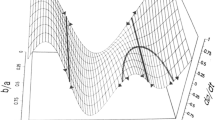Summary
A theorem presented by Hornik, Stinchcombe, and White (1989) suggested the possibility that connectionist networks could be effectively Turing machines. Levelt (1990) argued that the theorem of Hornik et al. only implies that networks are finite-state machines and are therefore not capable of generating the very unlimited productivity of symbol systems. Yet it can be argued that all real machines, including the brain, are finite-state machines. If so, no real machine actually possesses the very unlimited productivity of symbol systems. So any model of actual behaviour should capture the limitations on productivity inherent in the situation. Thus connectionist networks can be valuable models in psychology, precisely because they are finite-state machines.
Similar content being viewed by others
References
Brainerd, W. S., & Landweber, L. H. (1974). Theory of computation. New York: John Wiley.
Cybenko, G. (1989). Approximation by superpositions of a sigmoidal function. Mathematical Control Signals Systems, 2, 303 -314.
Feynman, R. P., Leighton, R. B., & Sands,M. L. (1989). The Feynman lectures on physics: Commemorative issue. I. Reading, MA: Addison-Wesley.
Fodor, J. A., Pylyshyn, Z. W. (1988). Connectionism and cognitive architecture: A critical analysis. In S. Pinker and J. Mehler (Eds.), Connections and symbols (pp. 3 -71). Cambridge, MA: MIT Press.
Funahashi, K. (1989). On the approximate realization of continuous mappings by neural networks. Neural Networks, 2, 183–192.
Halmos, P. R. (1974). Measure theory. New York: Springer.
Hornik, K., Stinchcombe, M., & White, H. (1989). Multilayer feedforward networks are universal approximatcrs. Neural Networks, 2, 359–366.
Levelt, W. J. M. (1974). Formal grammars in linguistics and psycholinguistics (3 vols.). The Hague: Mouton.
Levelt, W. J. M. (1989). De connectionistische mode: Symbolische en subsymbolische modellen van menselijk gedrag. In C. Brown, P. Hagoort, & T. Meijering (Eds.), Vensters op de geest: Cognitie op het snijvlak van filosofie en psychologie (pp. 202–219). Utrecht: Stichting Grafiet.
Levelt, W. J. M. (1990). Are multilayer feedforward networks effectively Turing machines? Psychological Research. 52, 153 -157.
Marr, D. (1981). Artificial intelligence: A personal view. In J. Haugeland (Ed.), Mind design (pp. 129–142). Cambridge, MA: MIT Press.
McCulloch, W. S., & Pitts, W. (1943, repr. 1988). A logical calculus of the ideas immanent in nervous activity. In J. A. Anderson & E. Rosenfeld (Eds.), Neurocomputing: Foundations of research (pp. 18–27). Cambridge, MA: MIT Press.
Minsky, M. L. (1967). Computation: Finite and infinite machines. Englewood Cliffs, NJ: Prentice-Hall.
Misner, C. W., Thorne, K. S., & Wheeler, J. A. (1973). Gravitation. San Francisco: Freeman.
Rogers, H. (1988). Theory of recursive functions and effective computability. Cambridge, MA: MIT press.
Rudin, W. (1976). Principles of mathematical analysis. New York: McGraw-Hill.
van der Velde, F. (1992). Feedforward networks as recursive functions. Technical report. Leiden University.
Wasow, T., (1989). Grammatical theory. In M. I. Posner (Ed.), Foundations of cognitive science (pp. 161–205). Cambridge, MA: MIT Press.
Zeidenberg, M., (1990). Neural networks in artificial intelligence. New York, Ellis Horwood.
Author information
Authors and Affiliations
Rights and permissions
About this article
Cite this article
van der Velde, F. Is the brain an effective Turing machine or a finite-state machine?. Psychol. Res 55, 71–79 (1993). https://doi.org/10.1007/BF00419895
Received:
Accepted:
Issue Date:
DOI: https://doi.org/10.1007/BF00419895




